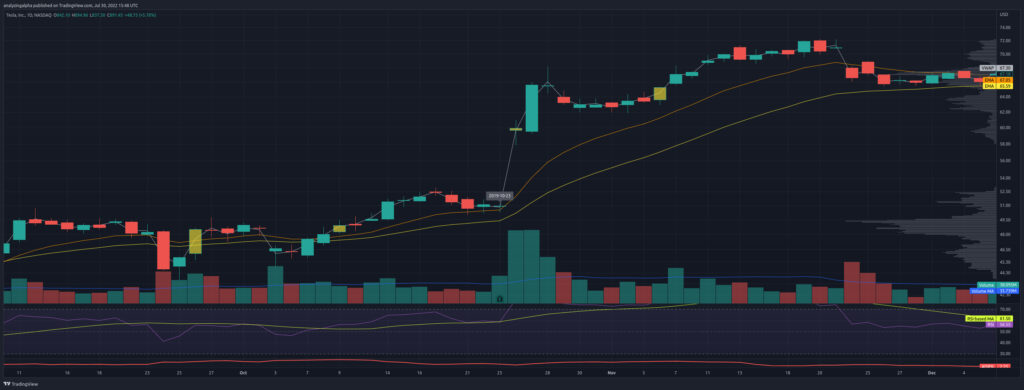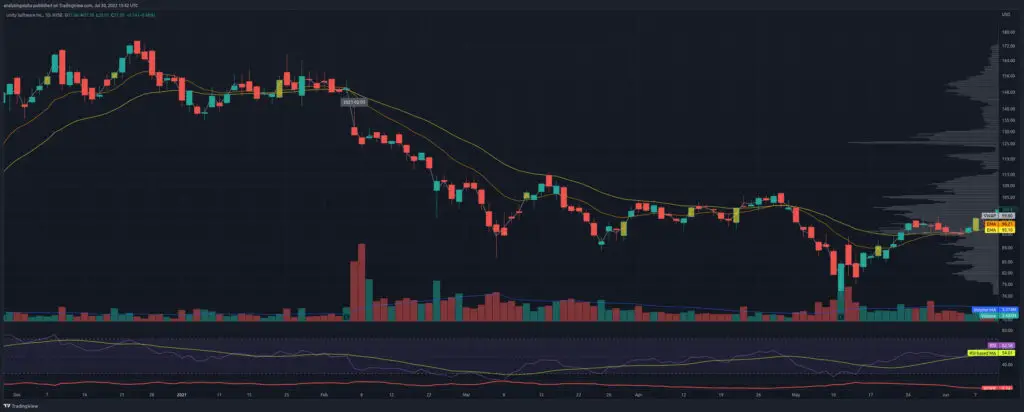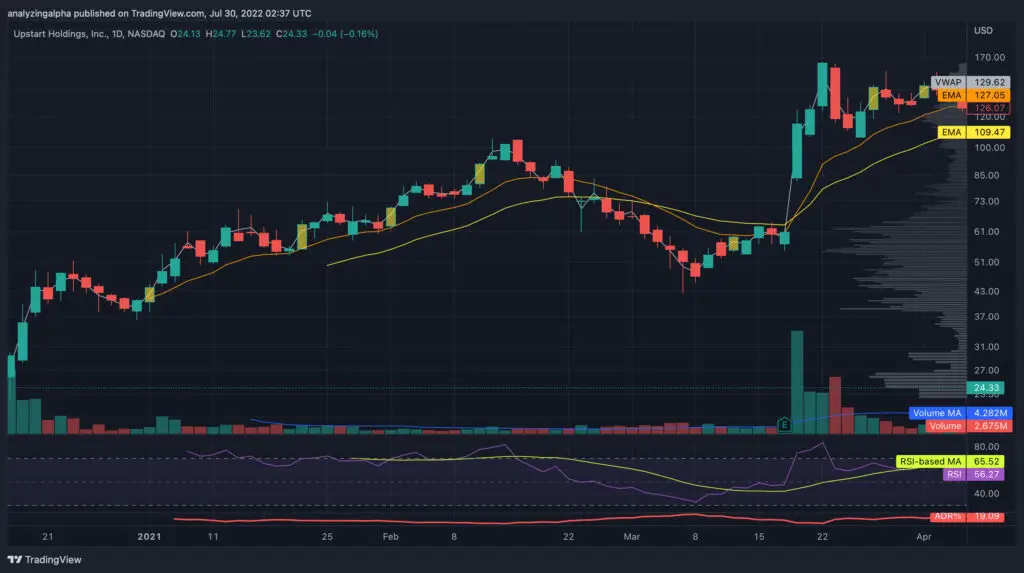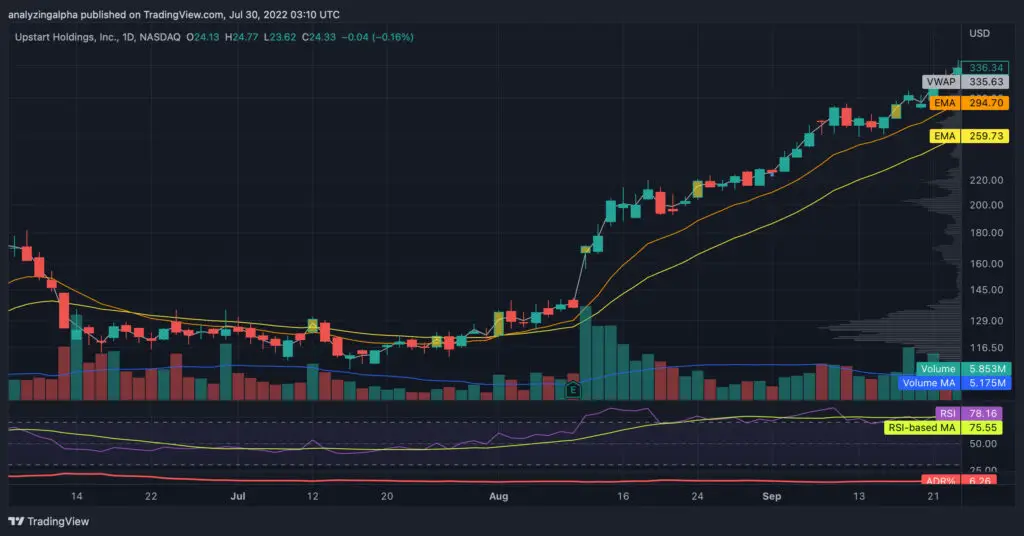Episodic Pivots are a trading pattern that occurs when a stock’s story changes significantly, represented by a 10% or more price move due to an earnings announcement or catalyst.
Understanding and exploiting the episodic pivot pattern is one of the fastest ways for new traders to attain profitability. The reason is simple – this pattern works in all markets.
Interested?
Read on to learn how Qullamaggie compounds at over 300% annually using this pattern… and no, that’s not a typo.
What Is an Episodic Pivot?
The episodic pivot is a play on we humans’ tendency to underreact earnings announcements.
The anomaly that stocks tend to move in the direction of the earnings surprise for nearly sixty days after the earnings announcement is called post-earnings announcement drift (PEAD).
Pradeep Bonde from Stockbee studied the PEAD anomaly and created a trading setup exploiting it, and Qullamaggie’s astronomical returns make it famous.
Why Do Episodic Pivots Work?
The critical understanding is that institutions move the markets. An institution will value a company using a discounted cash flow model to determine where the price an equity should trade. When a company announces unexpected earnings, institutions must update their Excel DCF models and quickly buy the stock if the new estimated price is significantly higher than the current trading price.
The challenge for institutions is that they have massive portfolio sizes relative to retail investors and need to buy with big volume often spanning weeks or many months to get to their desired allocation. This is especially true for lower float stocks.
Let’s learn how to add rocket fuel to our swing trading portfolio by learnings how to identify these episodic pivots.
How to Identify an Episodic Pivot

The following are requirements for a valid episodic pivot pattern:
- There must be a price gap of at least 10%.
- The stock must trade the average daily volume within 20 minutes.
- The story must change. E.g., the price move must be in the opposite direction of the long-term trend or out of long-term consolidation.
We can see a clear example of this on the Tesla daily chart, occurring on October 24th, 2019. We all know what happens next…
And while my definition may be different than Pradeep Bonde’s or Qullamaggie’s. The key idea that we all share is that the story must change.
This story change can come in the form of new business partnerships, FDA approvals, sector deregulation news, etc. Again, it’s all about big moves caused by institutional buying and selling pressure. Anything that changes earnings expectations in a significant way that causes institutional pressure. And the best catalyst of all is when a company provides a blowout earnings surprise and a stellar forecast.
With an understanding of how to identify episodic pivots, what is the optimal trading strategy? How can we best profit from this catalyst?
How to Trade Episodic Pivots
You can buy episodic pivots right after a positive earnings release in extended-hours trading using a service like breifing.com or wait until the market opens. Since there are significant risks and capital limitations in extended-hours trading, we’ll focus on trading this range expansion during regular hours.
Assuming you’ve identified an episodic pivot, there are two primary ways to enter successfully.
Opening Range Breakout Entry

The first is the opening range breakout popularized by Kristjan and Pradeep. The idea is to enter early and often.
We see this play out on the World Fuel Services (INT) 5-min chart on July 29th, 2022.
The logic is that if you’ve identified a true EP breakout, the earlier you enter, the better your risk-reward dynamics. Your stop will be tighter, and your potential reward will be higher. This often means entering in on a break of the 1-minute candle, assuming your stop is within 1.5x the average daily range.
The average daily range is the same as the more popular average true range, but it does not consider overnight gaps.
Speaking of your stop loss, it is always set just below the day’s low. If the stock is breaking out due to institutions buying pressure, it’s unlikely to revisit the day’s low.
In situations where the volume doesn’t come in immediately, you may need to wait until a break of the 5-minute or 60-minute candle.
And while entering in at the break of the opening range highs is the setup most traders use, it’s not the only one.
The Fishhook Entry

Scot1land developed this fishhook trading strategy to take advantage of the continuation of an earnings move while reducing the initial profit-taking reaction. It’s excellent for those who want more confirmation.
He noticed that many stocks would make a big move out of momentum gaps one day and then come crashing back to earth the next.
He also noticed that the strongest stocks bucked this trend and would recover on abnormal strength. These were the true buyable gap ups.
These big movers would have an earnings EP with significant volume, retrace back below the first day’s close due to profit taking, and then recover to new highs — essentially making a fishhook shape.
The entry is triggered after a reclaim of the first day’s close — typically within two-four days after the initial profit-taking.
The stop loss follows the same logic.
It’s set at the low of the fishhook trigger bar. If the selling has subsided and institutions want in, that bar is likely low.
Episodic Profit Taking
Profit-taking is more art than science. It depends on the market regime, your position size, and a host of other factors, but I’ll provide some general rules for those new to these explosive moves.
You’ll want to use moving averages for taking profits. Take partial profits at a close below the 10-day simple moving average and the remainder below the 20-day moving average.
If that makes you nervous, you can use a trailing stop. The challenge is that if this is a true EP, institutions have already placed their orders, and their order execution algorithms are just waiting for an opportunity to buy at a discount. In other words, you’ll notice that the price quickly moves back above the key moving averages.
Episodic Pivot Examples
Upstart Episodic Pivot Example on 2021-03-17

We can see a perfect example of a great EP with Upstart on March 17th, 2021. Price has been moving roughly sideways since the IPO for 13 weeks. We see that the price is below the 12 and 26 exponential moving averages with a large amount of volume traded in that area, as seen by the volume profile. The company broke the news of its sales growth in extended hours and made a big move, trading more volume than on its IPO day.
In other words, the story changed, making institutions buy.
The post-earnings drift anomaly netted a trader over 40% in roughly 17 days following the moving average sell rules discussed above.
But this wasn’t the only quarter where we saw Upstart make the market think twice.
Upstart Episodic Pivot Example on 2021-08-11

We see another excellent example of post-earnings announcement drift with Upstart on August 11th, 2021. Price was moving sideways for almost a quarter, with most trades occurring around the pre-EP price. We see a large move up on multiples of the average daily volume.
And what happens? The market finally listens. With another blowout quarter, the stock moved, and traders with a position profited handsomely with over a 100% gain in 53 trading days.
How to Scan for Episodic Pivots
Now that you know how to identify an episodic pivot, it’s easy to find stocks that meet the criteria.

You can use a news site such as the Wall Street Journal’s Extended Hours Stocks. Or you can use scanning software such as TradingView to search for episodic pivot trade ideas looking for an extended hours power earnings gap.
Price Earnings Gaps vs. Episodic Pivots
A big mistake I see from the Twitter trading gurus is that they call any price earnings gap (PEG) an episodic pivot. Just because a stock has a power earnings gap or gaps up on an earnings report does not mean it is an episodic pivot.
The key is that the story has to change. And while an analyst upgrade from improved analyst coverage helps, it’s about price. The charts show clearly show that something significant has changed. It is a new episode in the life of the company and its share price.
Episodic Pivot Trading Tips
Since my trading is rooted in academic research, I traded PEAD before I heard the term Episodic Pivot. Here are a few tips and trade ideas that academic research doesn’t tell you.
1. Execute Early
The biggest moves can be hard to catch. The massive volume poured into the open might as well be called rocket fuel. You need to enter into the stock quickly. The best way to do this is to set a market order at the break of the opening range highs once its been identified. Don’t sit there fumbling trying to place the order and calculate the shares, letting the trade get away from you. Have the number of shares and price preprogrammed.
2. Pump Up The Volume
The best post-earnings announcement drift earnings breakouts come from high volume. Analyzing the volume profile, we can get an idea of the type of volume needed to bring the stock into a rough equilibrium. If there’s a gap up above a massive volume shelf, it significantly increases the odds of the power earnings gap being one of the biggest movers.
Why?
Think what a volume shelf in our chart means. It means that there are a lot of institutions that believed the volume shelf area was a reasonable price. These institutions will now need to update their pricing models and make a move on the stock.
3. Exploit Algorithmic Execution
If you closely observe action around popular moving averages, you’ll notice that algorithmic execution isn’t that complicated. If there’s a gap up above key moving averages, algos will often cover shorts and go long, causing buying pressure.
Some of the best buyable gap ups I’ve seen are where there’s a massive volume shelf gapping up above key moving averages.
4. Don’t Choke
Contrary to most day trading recommendations, you won’t want to move your stop loss to break even on the first day, as it substantially increases the risk of being stopped out.
The Bottom Line
An episodic pivot looks to maximize the post-earnings drift anomaly’s risk and return potential. The fundamental logic is that price tells a story, the story can change, and you want to be in early when it does.